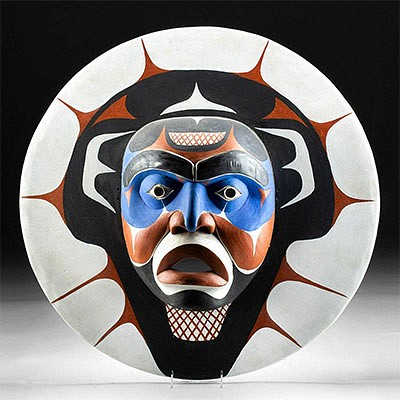Rare Veracruz Totanac Andesite Tenon Muscovy Duck
Lot 40
About Seller
Artemis Fine Arts
686 S Taylor Ave, Ste 106
Louisville, CO 80027
United States
Selling antiquities, ancient and ethnographic art online since 1993, Artemis Gallery specializes in Classical Antiquities (Egyptian, Greek, Roman, Near Eastern), Asian, Pre-Columbian, African / Tribal / Oceanographic art. Our extensive inventory includes pottery, stone, metal, wood, glass and textil...Read more
Estimate:
$2,500 - $3,500
Absentee vs Live bid
Two ways to bid:
- Leave a max absentee bid and the platform will bid on your behalf up to your maximum bid during the live auction.
- Bid live during the auction and your bids will be submitted real-time to the auctioneer.
Bid Increments
| Price | Bid Increment |
|---|---|
| $0 | $25 |
| $300 | $50 |
| $1,000 | $100 |
| $2,000 | $250 |
| $5,000 | $500 |
| $10,000 | $1,000 |
| $20,000 | $2,500 |
| $50,000 | $5,000 |
| $100,000 | $10,000 |
| $200,000 | $20,000 |
About Auction
By Artemis Fine Arts
Mar 18, 2021
Set Reminder
2021-03-18 10:00:00
2021-03-18 10:00:00
America/New_York
Bidsquare
Bidsquare : Pre-Columbian | Tribal | Oceanic
https://www.bidsquare.com/auctions/artemis-gallery/pre-columbian-tribal-oceanic-6520
Featuring Pre-Columbian, Native American, African / Tribal, Oceanic, much more. All items have been legally acquired and are legal to sell. Convenient in-house shipping. Artemis Fine Arts info@artemisgallery.com
Featuring Pre-Columbian, Native American, African / Tribal, Oceanic, much more. All items have been legally acquired and are legal to sell. Convenient in-house shipping. Artemis Fine Arts info@artemisgallery.com
- Lot Description
Pre-Columbian, East Mexico, Veracruz culture, also known as Totonac (Totonaca), Remojadas, Classic period, ca. 300 to 600 CE. This finely carved andesite sculpture represents the head of the oldest domesticated species of duck in the world, the Muscovy duck. This crested head may have functioned as a tenon, possibly architecturally but certainly in a ritual context. The gray-brown stone is polished on the cheek areas and the bill. The details are well preserved and even include nostrils on the bulbous tip of the duck's bill. The tenon was shaped by pecking and polishing to capture the charming face of the bird. This is an unusual and rare example of ancient artistry that paid homage to a very important bird in Veracruz culture! Size: 5" W x 6.25" H (12.7 cm x 15.9 cm)
The feathers of the Muscovy duck were a decorative symbol of royalty. The males of the species are frequently aggressive, making the bid a special symbol for warriors. The Lord of Sipan was even buried with ear spools decorated with Muscovy ducks, probably to emphasize his status as a powerful warrior.
Provenance: ex-old private New England collection, acquired in the 1970s; ex-private Ft. Lauderdale, Florida, USA collection
All items legal to buy/sell under U.S. Statute covering cultural patrimony Code 2600, CHAPTER 14, and are guaranteed to be as described or your money back.
A Certificate of Authenticity will accompany all winning bids.
We ship worldwide and handle all shipping in-house for your convenience.
#162455Abrasion and loss to top of beak. Some chips and abrasions to neck and crest. Great preservation of details.Condition
- Shipping Info
-
All shipping is handled in-house for your convenience. Your invoice from Artemis Gallery will include shipping calculation instructions. If in doubt, please inquire BEFORE bidding for estimated shipping costs for individual items.
-
- Buyer's Premium



 EUR
EUR CAD
CAD AUD
AUD GBP
GBP MXN
MXN HKD
HKD CNY
CNY MYR
MYR SEK
SEK SGD
SGD CHF
CHF THB
THB















